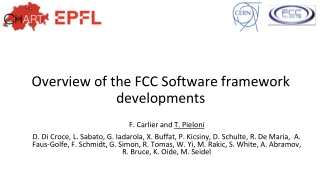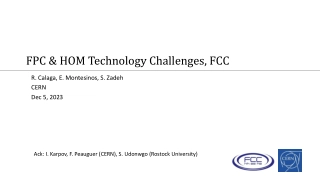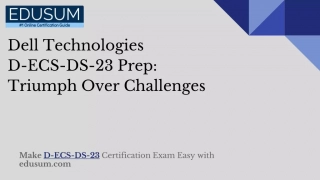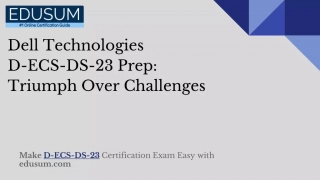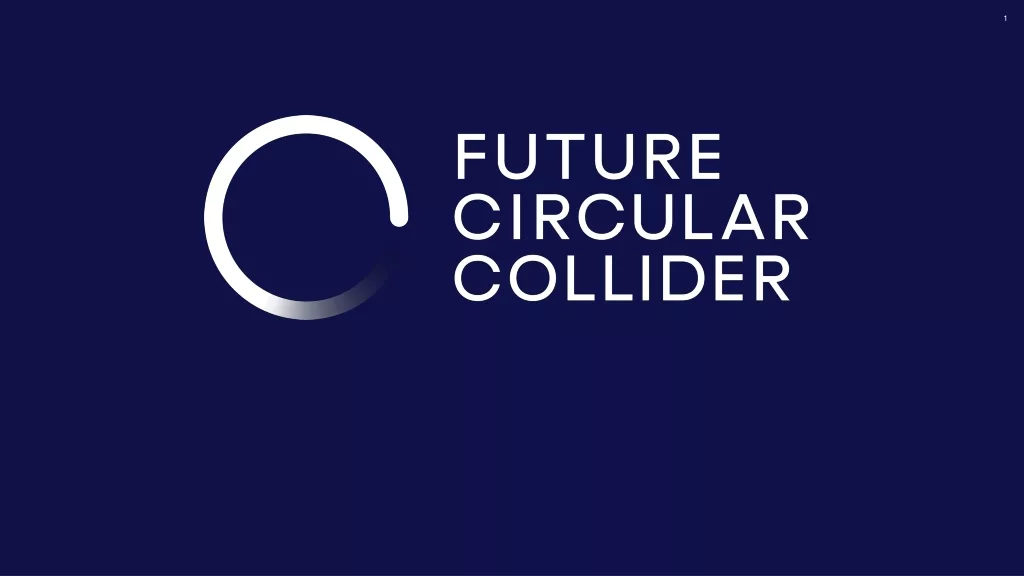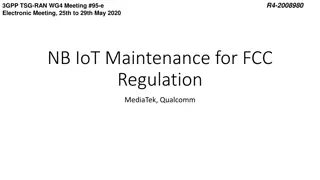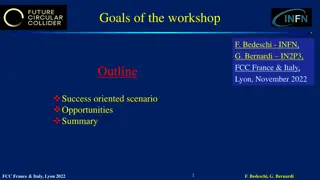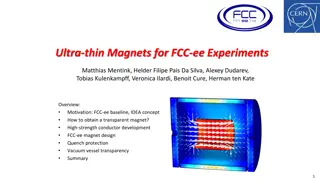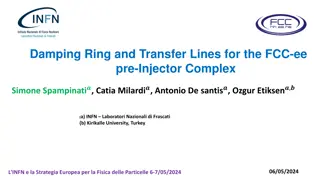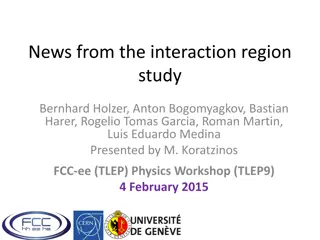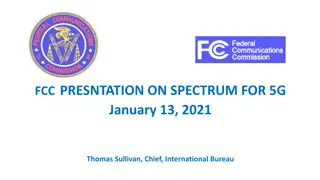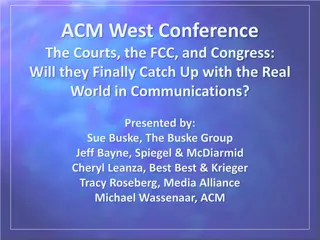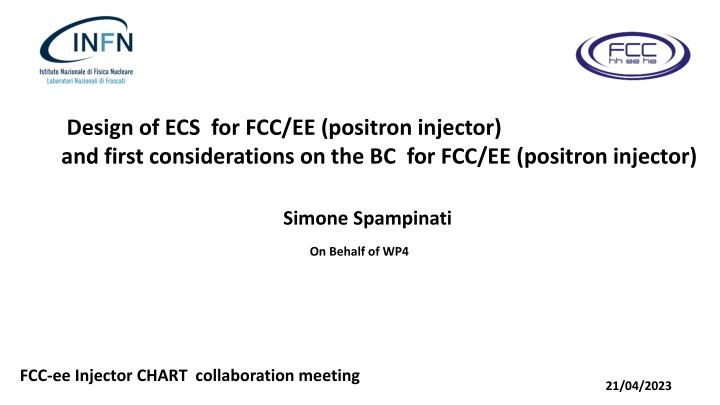
Design considerations and analytical calculations for FCC/EE positron injector
Explore the design of Electron Cooling System (ECS) for FCC/EE's positron injector, including RF cavity design and dispersion considerations, along with analytical calculations for particle fractions and energy distributions. Details on accelerating voltages, beam energy optimizations, and the importance of zero crossing in compression are highlighted.
Download Presentation

Please find below an Image/Link to download the presentation.
The content on the website is provided AS IS for your information and personal use only. It may not be sold, licensed, or shared on other websites without obtaining consent from the author. If you encounter any issues during the download, it is possible that the publisher has removed the file from their server.
You are allowed to download the files provided on this website for personal or commercial use, subject to the condition that they are used lawfully. All files are the property of their respective owners.
The content on the website is provided AS IS for your information and personal use only. It may not be sold, licensed, or shared on other websites without obtaining consent from the author.
E N D
Presentation Transcript
Design of ECS for FCC/EE (positron injector) and first considerations on the BC for FCC/EE (positron injector) Simone Spampinati On Behalf of WP4 FCC-ee Injector CHART collaboration meeting 21/04/2023
Basic ECS design Dispersive path R56 RF cavity at zero crossing to compensate the linear chirp A C-shape chicane. Dispersion and second order dispersion closed by symmetry The beam exits from the ECS on the same LINAC axis and a single diagnostic line can be used for the tuning of the LINAC and of ECS Simulations and calculations presented done starting from this beam Calculation to be repeated 1D RF field map 2 D RF field map
Analytical calculations Fraction of particles in E0( peak)+/-30MeV as function of R56 and accelerating voltage 2GHz phase 0 Fraction of particles in E0+/-30MeV |R56|>0.22m and RF VOLTAGE >80 MV are required to have a fraction of particles In +/-2% >0.85
Basic ECS design RF cavity at zero crossing to compensate the linear chirp Dispersive path R56 C-shape chicane Two cavities of the type used for the positron LINAC ( PSI design of the positron LINAC THPOJO08 LINAC 2022) Parameter Value Unit Bending angle 0.265 (15) Rad (deg) Magnetic length 1 m Distance between magnets 1 m R56 0.25 m Max dispersion 0.56 m Number of cavity 2 RF frequency 2 GHz Accelerating gradient 20 MV/m Accelerating voltage 120 MV
Beam energy distribution Elegant tracking of the distribution provided by Mathias Zero crossing is more effective to compress the energy distribution respect to an accelerating phase so it is better to increase the beam energy at the exit of the LINAC to compensate the energy change of the peak of the distribution in ECS In the chicane the beam length increases from 2mm to 4cm. Acceleration of particles at different phases would increase the energy spread
Fraction of particles in E0+/-30MeV in function of E0 Good agreement between analytics calculation at the first order ant elegant tracking at the second order. Linear model of CSR included in ELEGANT It is better to work at the zero crossing to have an higher number of particle in +/-2% 0.86 Fraction of particles in E0+/-30MeV
ECS design Quads for transvers focusing Quads for Dispersion compensation Total length 19m 4 2 1 3 4 2 3 1
Tolerance on RF -/+2% variation of the cavity voltage -/+1 deg variation of the RF phase Tolerance of Amplitude and phase variation relaxed Radial variation of the accelerating voltage below few %
Middle of the chicane the dispersion Cutting a very small part of the beam change the transvers size (sigma) of the beam Horizontal size of the beam in the middle of the chicane is dominated by Middle of the chicane Initial energy distribution
Middle of the chicane the dispersion 97% of the beam is in 20cm Collimator can be add. 1% is 50pc Horizontal size of the beam in the middle of the chicane is dominated by 97% 97%
Tolerances and corrections Tolerances of 2*10^-4 and 2*10^-3 quadrupole and sextupole components of the dipoles 2 and 3 on the are enough to preserve emittance but generate 200 m dispersion Two quads with magnets length of 5 cm and a |K| 0.01 reduce this dispersion to m level Trim coils to compensate variation between the dipoles up to 0.1%
Results and conclusions An ECS based on a chicane can increase the number of particle with the right energy to be injected in the DR Good agreement between the tracking and the analytical theory ECS shifts the peak of the distribution. It is Better to increase the LINAC energy A four chicane is a simple choice for the dispersive region as the dispersion is closed The beam exits from the ECS on the same LINAC axis and a single diagnostic line can be used for the tuning of the LINAC and of ECS ELEGANT 1 D model and 3D calculation In steady state don't show important CSR effect on emittance on emittance grow G. Stupakov, PRAB,25, 014401 (2022). Transient effects should be small too Tolerances on radial variation of RF voltage and phase-amplitude variation relaxed Big horizontal dimension of the beam in the chicane. Large vacuum chamber .
BC purposes and constrains Beam distribution after the damping Equilibrium zero current bunch length 2.9mm (4MV) Expected bunch length <5mm Equilibrium zero current bunch energy spread 0.07% Expected Bunch energy spread 0.1% Equilibrium zero current emittance 0.96 nm (normalized emittance(2.9 mm*mrad)) Beam distribution at the high energy LINAC Bunch compressor requirements Compressor factor 1-5 variable Final relative at energy spread after bunch compressor at 1541MeV <0.65% Preserve transverse emittance. 20% between emittance required by the high energy LINAC and the equilibrium emittance of the damping ring Bunch length 1mm Relative bunch energy spread < 0.65% at 1541MeV Normalized transverse emittance 3.4 mm*mrad
Final relative energy spread after bunch compressor at 1541MeV <0.65% ?? ??<1.3 ? Max C= ? ??? ?= ? ? = |R56|>0.62m A de-chirper after the dispersive section can reduce the needed R56 ?? ??<2.2 ? ? = Max C= ? ??? ?= ?|R56|>0.4m R56 high for a single chicane R56 *??/ >400 m microbunching instability suppressed by energy spread Cavity parameters ( PSI design of the common LINAC THPOJO08 LINAC 2022) frequency 2.80GhZ 84 cells for 3m structure One structure operating at a gradient of 20MV/m (60MV total) to chirp the beam Two structures operating at a gradient of 25MV/m (75MV total) to de-chirp the beam
TEST WITH A C-SHAPE CHICANE DE-CHIRPER (TWO CAVITIES) A c-shape chicane, R56=-0.4m Simulations with elegant. 1D CSR model. 4 million particle 20% emittance increase from 2.9mm*mrad to 3.5mm*mrad
Pre injector complex with Positron bunch compressor RF cavity to chirp Arc compressor De-chirper (optional) Small R56 from the transfer line (optional)
Arc options Design An isochronous arc based on TBA cell already designed (C.Milardi A.De Santis LNF-INFN, Italy) A new arc based on TBA can be designed to have a proper R56 Other option: Cel based on DBA FODO arc Prescription to reduce CSR effects on emittance Small angles Cancellation of Coherent Synchrotron Radiation Kicks with Optics balance. Demonstrated for a transfer line (two DBA) S. Di Mitri, M. Cornacchia, and S. Spampinati, Balance Phys. Rev. Lett. 110, 014801 (2013) Studied for arc compressors ) S. Di Mitri, M. Cornacchia, EPL 109 (2015) 62002 C.Bacci et al. Phys. Rev. Accelerator and beam 22, 111304 (2019) H function control

